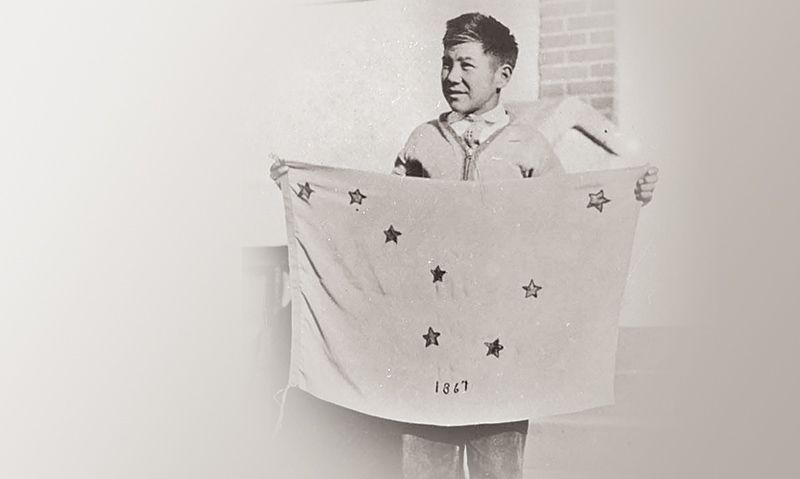
Newly chosen flag accompanied Legion contingent to Paris convention.
The Seward Gateway newspaper announced a competition to design the Alaska state flag on Dec. 31, 1926. The story begins earlier in 1926 when George Parks, governor of the territory of Alaska, called on the Postmaster General in Washington, D.C. Parks noted that the rotunda of the Federal Post Office Building featured a spectacular display of flags of all the states and territories, except Alaska.
On his return to Alaska, Parks met with The American Legion and suggested they sponsor a contest, through the schools, for the creation of an official Alaskan flag.
By January 1927 the rules had been sent out. In each town, a local board of judges was set up. This group was to choose the 10 best designs and forward them to the department adjutant in Juneau by March 1, 1927, for submission to the Final Awards Committee. The contest was open to all schools, public and private, for students enrolled in the seventh through the 12th grades.
Designs came in from all over the territory. The Territorial Legislature was invited to appoint two members from each house to sit with three members of The American Legion, comprising the committee.
When the decision was made, the Gateway headline read: “LOCAL POST AWARD FOR DESIGN OF TERRITORIAL FLAG.” The article went on to say, "On Tuesday evening at the Seward Grill, the Seward post of The American Legion held one of the largest and most interesting meetings of the post for some time. The principal business of the evening was the installation of the officers for the ensuing year and the initiation of two members. The new members were Jasper Holman and Bob Evans …. The post voted to award prizes of $5, $3 and $2 for the best design for a territorial flag submitted by the schools in the jurisdiction of the post.”
The winner of the competition was Benny Benson, a 13-year-old in the Jesse Lee Orphanage in Seward. Benson’s design was supported by Post 5. In all, 142 designs were submitted across the state. The flag was adopted by the Territorial Legislature in May 1927 and remains Alaska's official flag.
On his design submission, Benson had also written some words of explanation: “The blue field is for the Alaska sky and the forget-me-not, an Alaska flower. The North Star is for the future of the state of Alaska, the most northerly in the Union. The dipper is for the Great Bear – symbolizing strenth (sic).” His original entry is housed in the Alaska State Museum collection.
The flag is dark blue, with eight five-pointed gold stars in the shape of the Big Dipper and a slightly larger gold star representing the pole star, Polaris.
Through the Flag Act found in Alaska House Bill 91, $1,000 was appropriated to fly Benson to Washington, D.C., to present a flag to President Calvin Coolidge, and another $1,000 to fly him to the Paris American Legion national convention later that year; however, since satisfactory arrangements could not be made to meet with the president, the act was modified so Benson could use the money for his education.
On July 9, 1927, the first unfurling of the flag occurred at the dedication of the Jesse Lee Home at Seward. At 4 p.m., the official flag of Alaska was flung to the breezes for the first time on the Jesse Lee flagpole.
The Alaska flag was escorted to the Paris convention. The Gateway reported that "HJ Thompson (Alaska Department of France convention officer) of Juneau left on his way to France as head of the French Convention Department from Alaska, taking with him the recently adopted flag of Alaska. He will meet his wife in New York, where she has been visiting for the last month, and she will accompany him to Paris." The Alaskan contingent to Paris comprised 31 Legionnaires.
Benson lived in Alaska more or less his entire life, and became a goodwill ambassador for the state.
For more information on Post 5, visit their Centennial Celebration page.
- FODPAL

